 |
 |
|
|
| “Shrines and Temples of Nikko” were registered as World Heritage site at the 23rd session of the UNESCO World Heritage Committee held at Marakesh in Morocco in December 1999. The site consists of two Shinto shrines (Futarasan Shrine, Toshogu Shrine) and Buddhist temple (Rinnoji Temple). There are 103 historical buildings consisting of 9 national treasures and 94 important cultural properties. Most of the buildings were constructed by the greatest artists in the 17th century, and their artistic values are very high. Also, Nikko played an important role in supporting political structure of Edo period. For example, successive shoguns, envoys dispatched from imperial court in Kyoto, diplomatic envoys from Korea, they visited to Nikko. Moreover, those buildings are well harmonized with natural environment in order to take place for religious activities to worship mountains of Nikko. |
| Toshogu Shrine |
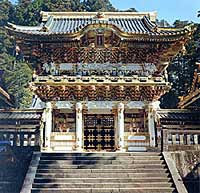 |
Toshogu was originally constructed in 1617, a year after Ieyasu Tokugawa died. The reason why Toshogu was erected in Nikko, was because directional relationship with Edo. Nikko is located in the north of Edo. Ieyasu defined Nikko as the center of Edo (or whole nation) by referring the relationship between the polestar and universe. His intention was to protect the whole nation by being the polestar of Edo. Although Toshogu was constructed in a small sized and simple shrine as Ieyasu’s last will, the shrine was reconstructed and expanded to larger size and became more gorgeous in color in 1636. |
| Events and Heritages There are 8 national treasures and 32 important cultural properties in Toshogu. Also, seven annual events have been taken there. Some examples are as follows: •Procession of a Thousand Warriors [May 17th to 18th, October 17th] •The Gojuunoto (Five storied pagoda) •The Omizuya •The Shinkyu (Sacred Horse Stable) •The Sansaru (Three Monkeys) •The Yomeimon Gate (Sunlight Gate) •The Shourou, Korou, Honzi-do (Belfry and Drum Tower, Honzi-do hall) •The Nakiryu (Crying Dragon) •The Nemurineko (Sleeping Cat) |
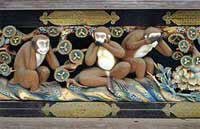 |
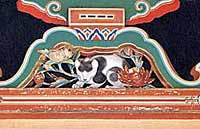 |
| The Sansaru (Three Monkeys) | The Nemurineko (Sleeping Cat) |
| Rinnoji Temple |
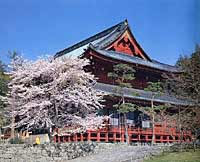 |
Rinnoji Temple is a generic term for temples, shrines, and 15 subordinative temples. The site thrived as a place for mountain worship and many Buddhist ascetics visited to practice since the priest Shoto constructed Shihonryuji Temple in the end of the 8th century. |
| Events and Heritages There are 37 important cultural properties and a national treasure in Rinnoji Temple. Also, 15 annual events have been taken there. Some examples are as follows: •Takigino (Noh plays) [Friday and Saturday around August 20th ] •Compulsory Rice Eating Ceremony [April 2nd] •The bronze statue of the priest Shoto |
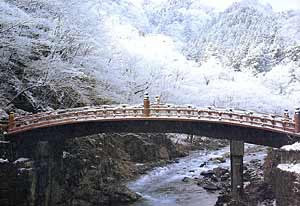 |
| The Shinkyo (Sacred Bridge) |
| Oku-Nikko is the area of the whole place from Chuzenji Temple to Yumoto, while are located in the northwestern part of Tochigi Prefecture, escaping from central Nikko with Shrines and Temples, and having gone up the long winding curve called Iroha-zaka. This area is a tourist resort region blessed with natural resources, such as marshland, Senjo-ga-hara, Lake Chuzenji, Kegon waterfall, and the outstanding scene including Mt. Nantai. Hiking, autumnal leaves, mountain climbing, camping, fishing, photography, the recreation at a hot spring will interest visitors. |
| Lake Chuzenji |
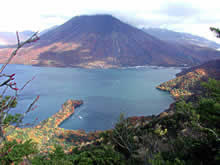 Lake Chuzenji has about 25km surroundings and its size is the No.1 of the natural lake inJapan. There is the Chugushi shrine, which religiously belongs to Nikko Futarasan Shrine. Also, Chuzenji Temple of Mt. Nikko, Chuzenji hot spring, camp, cottage of foreign embassy are around the Lake Chuzenji. Also, the location of the Chugushi shrine is an approach to Mt. Nantai. In addition, you can enjoy hiking to stroll around, and riding on the motorboat, which make a tour on the Lake Chuzenji. Lake Chuzenji has about 25km surroundings and its size is the No.1 of the natural lake inJapan. There is the Chugushi shrine, which religiously belongs to Nikko Futarasan Shrine. Also, Chuzenji Temple of Mt. Nikko, Chuzenji hot spring, camp, cottage of foreign embassy are around the Lake Chuzenji. Also, the location of the Chugushi shrine is an approach to Mt. Nantai. In addition, you can enjoy hiking to stroll around, and riding on the motorboat, which make a tour on the Lake Chuzenji.Foreigners' domestic tour became free gradually at the Meiji era, and the diplomats of Western countries came to visit to pass the summer. Cottages were built to the lakeside and the Japanese Imperial Family, a Japanese aristocrat, etc. came to visit also. The yacht race was opened there, an airplane came flying for movement. There was a Western atmosphere there. Fishing was the most popular play among the visitors. It was British style trout fishing (fly-fishing), and was carried in for the first time in Japan. "Tokyo Angling and Country Club" was inaugurated to enjoy golf and fishing at Senju-ha-hama beach. The members of the club consisted of the leader of political and business circles, the diplomat in Japan, and the Imperial Family. As a resort in which a high-class person gathers, the outskirts of Lake Chuzenji was established its status. Although there was also time currently called "Ministry of Foreign Affairs of summer" in early stages of Showa from Taisho, the area was damaged by World War II. Only the chimney of a fireplace portion stands still at the lakeside now. Although it is lonely, there was the romance. |
| Kegon Waterfall |
| The Kegon waterfall is recognized as one of the great waterfall of Nikko. The water of the Lake Chuzenji falls from a height of 97m. The elevator leads to observatory, and you will see a spray of powerful waterfall with beautiful scene. |
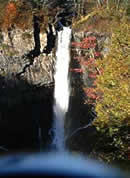 |
| Senjo-ga-hara |
 Senjo-ga-hara Senjo-ga-haraThe name of Senjo-ga-hara originates in the "battlefield" which appears in the myth. The struggle occurred regarding territorial possessions of Lake Chuzenji. The battle was done by the God of Futarasan of Shimotsuke (former Tochigi prefecture) and the God of Mt. Akagi of Kouzuke (former Gunma prefecture). Shimotsuke and Kouzuke are the countries, which adjoin across Lake Chuzenji. This battle was by the large herd of snake on Futarasan side, and the large herd of centipede on Mt. Akagi. The Futarasan was inferior in strength at the first time, but the God of the Futarasan remembered the man, who might defeat troop of the Mt. Akagi. He was the expert of a bow called Sarumaru. The God of the Futarasan tried to lure Sarumaru out by changing his appearance to the white deer. Sarumaru chased the white deer and came to Futarasan as the white deer intended. The God of Futarasan asked Sarumaru to defeat the troop of Mt. Akagi. Sarumaru found two-horned giant centipede, which seems to be the enemy’s leader. Sarumaru hit the left eye of the enemy's leader, and defeated enemy of the Mt. Akagi finally. Nature Senjo-ga-hara is one of the marshland representing Japan, and there is about 400ha of width. It is the treasury of an alpine plant and flowers, and can be enjoyed from June to August. Also, there are deciduous broad-leaved tree woods, such as a Japanese oak, HARUNIRE, and ZUMI around the marshland. Moreover, SHIRAKAMBA, which has a nickname as "Noblewoman of Odashiro-gahara”, is the popular target among the hiker and photographer. Wild birds Senjo-ga-hara is also well known for many kinds of wild bird. You will see them at the forest zone, and by walking along the "Senjo-ga-hara Natural Research Path". Those wild birds will multiply around May to July in Senjo-ga-hara. Weather Although many hikers visit Senjo-ga-hara in the blooming season of an alpine plant, weather of Senjo-ga-hara is not easily influenced even if it were the rainy season, while it is raining in the central Nikko. Therefore, you should better check the weather of both the station front and the destination. Skiing Senjo-ga-hara is covered with snow in winter, and is also the prosperous place of cross-country skiing. Various courses have gathered from the beginner course to the official-recognition course. Koutoku, which is located in the east of Senjo-ga-hara, is the starting point of each course. |
| Hiking around Lake Kirikomi, Lake Karikomi |
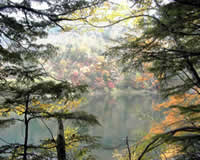 Beautiful autumn leaves Beautiful autumn leavesYou will enjoy the beauty of autumnal leaves of Oku-Nikko (literally "deep Nikko") in a comparatively easy hikingcourse of Lake Kirikomi and Lake Karikomi. It takes you 4, or 5 hours (9.6km long) including lunch time from Yumoto hot spring to Koutoku Pasture (or the reverse course) to complete the course. Relaxing at the Yumoto hot spring after the hiking will be great. It takes about one and half hour from Hatomachi-toge, Oze to Yumoro area. Course Information No rest room on the hiking course It is hard to walk from Koutoku to Sanno Touge mountain pass on the reverse course. Ordinary course is more comfortable. Parking lot available at Koutoku, but not at the Koutoku starting point for hiking. Please be careful of number of buses running between the Koutoku and Koutoku entrance. They are very few. The first ten or twenty days of October are the best season to observe autumn leaves. Highlight <A. Fountainhead of Yumoto > The source of a hot spring is located in the area Yuno-daira, Marshland to Lake Yunoko. The hot spring flows into Yuno-daira marshland and is cloudy. <B. Lake Kirikomi, Lake Karikomi> Both lakes are connected each other and there is no stream going out. <C. Kare-numa Dried up Swamp> The prairie looks like a grinding bowl. The flower of trees will mainly bloom in spring and summer. <D. Flower of trees> Most of flower of trees will bloom in July, August and September. <E. Wild bird> Time required ( ) is reverse course Yumoto onsen ~1hour (1hour) ~ Lake Karikomi ~ 1hour and half(1hour and 20 minutes) ~ Sanno mountain pass ~ 1hour(40 minutes) ~ Koutoku ~ 30 minutes(30 minutes) ~ Koutoku entrance |